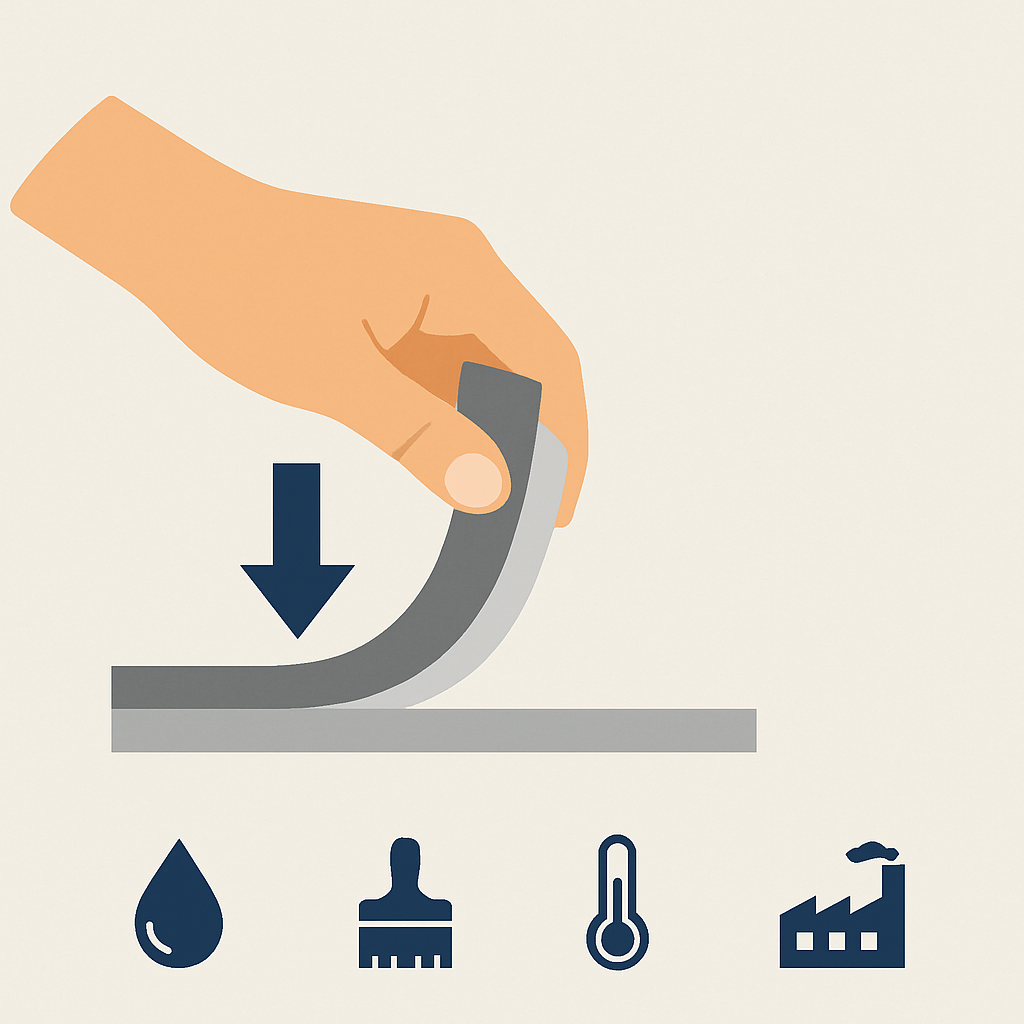When it comes to adhering to materials in industrial, automotive, construction, or consumer applications, adhesive strength and durability are critical to performance. Selecting the wrong adhesive, or not fully understanding the environment and stressors it will face can result in costly failures, delays, or rework.
This paper helps to explain what adhesive strength means and how it impacts the final performance of your assembly. Whether you’re in engineering or procurement, this guide will give you a clear picture of how to evaluate PSA’s based on strength and long-term performance.
Types of PSA
Solvent Acrylic gives excellent performance for a wide variety of difficult applications. Solvent PSA’s have excellent resistance to water, humidity, weather and offer high temperature performance. Solvent PSA is used on Gaska High Bond (GHB) and Polyethylene Mounting Tape (EM) so that no mechanical fastener is needed.
Emulsion Acrylic are lower cost than solvent based but can still provide outstanding performance depending on the application. They have good tack, are very clear, and are environmentally friendly. These tapes are meant to be used in conjunction with a mechanical fastener like screws, rivets, compressed between 2 layers, etc.
What Is Adhesive Performance?
Adhesive performance refers to the force required to separate two materials joined by an adhesive. It reflects how well an adhesive bonds to a substrate and resists mechanical forces. Adhesive strength is measured in various ways depending on the application:
- Tack – Tack measures how quickly an adhesive bonds to a substrate but does not have a major impact on the longer term performance.
- Shear and Tensile Strength – Resistance to sliding forces parallel to the surface or separating rigid materials by pulling them apart. This is especially important on a tape that is coated on both sides, like GHB where a permanent bond, without the need for mechanical fastener is required.
- Peel strength – Resistance to peeling or lifting, often measured at specific angles. Peel strength is particularly important in applications where materials may flex or be pulled at an angle such as in gaskets, automotive seals, or consumer electronics. Shear and Peel are not the same and selecting an adhesive for the wrong reason will impact performance
Acrylic Pressure Sensitive Adhesives
- Offer high shear and peel strength
- Excellent resistance to UV, temperature, and chemicals
- Applied with pressure, no curing required
- Used for gaskets, labels, tapes
- Performance varies widely based on formulation
Factors That Affect Adhesive Performance
Understanding adhesive performance helps users predict how a bond will hold up in real-world conditions. Factors that influence performance are;
- Surface energy of the substrate. Low energy plastics like polyethylene and polypropylene are difficult to bond as is galvanized metal.
- Cleanliness of the substrate has a large impact. It can be enhanced by abrading, and cleaning. In the most difficult applications adhesion promoters may be necessary.
- Application method like applied pressure, application temperature, and time all affect the bond.
Real-World Applications
Let’s look at how adhesive strength and durability play out in common industrial settings:
- Automotive Gaskets – Modern vehicles use multiple adhesive backed gaskets throughout the vehicle. High peel strength ensures seals remain in place until the next step in the assembly process.
- HVAC and Appliance Assembly – Adhesive tapes are used to provide air tight seals between components. Resistance to heat and humidity is critical, making chemical peel strength data essential in product selection.
- Marine Equipment – Saltwater corrosion and UV exposure are constant challenges. Using foam tape that shows minimal degradation can extend the service life of marine electronics, control panels, and sealing systems.
- Permanent Adhesives – Gaska High Bond and Gaska’ s EM tapes can be used in applications where no mechanical fastener is desired. Trailers and buildings where no rivets or screws are used to create clean lines that won’t detract from the visual appearance.
Testing and Selecting the Right Adhesive
To choose the best adhesive, consider the following steps:
- Define the stresses: Are you dealing with shear, tensile, or peel forces?
- Review substrate compatibility: Check the adhesive’s performance on the materials you are bonding.
- Use data-driven charts: Reference an adhesive strength chart and chemical peel strength chart to compare performance metrics.
- Simulate conditions: If possible, conduct accelerated aging or chemical exposure tests.
At Gaska Tape, we work closely with clients to recommend adhesives tailored to their needs. From acrylic foam tapes to pressure-sensitive solutions, our products are designed to maintain high adhesive strength across a variety of stressors and environments.
Adhesive strength and durability are non-negotiable in industries where reliability, safety, and efficiency matter. By understanding how to interpret an adhesive strength chart and factoring in environmental and chemical exposures with a chemical peel strength chart, professionals can make informed decisions that enhance product performance and lifecycle.
Whether you’re in R&D or procurement, Gaska’s adhesive solutions offer proven, data-backed performance for demanding applications. Contact us today to request technical data sheets or discuss your specific application performance requirements.

